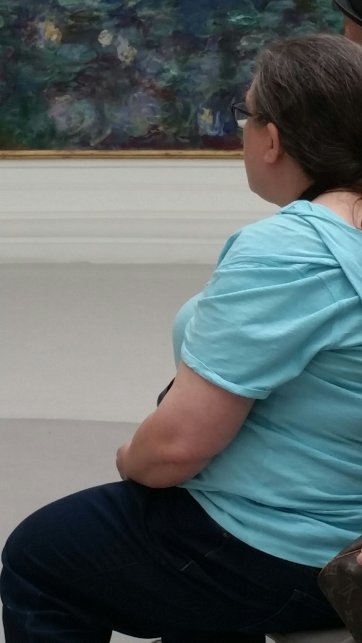Today, our third full day in Paris, the schedule was:
- Musee de L’Orangerie, with its two oval rooms immersing the viewers in Monet’s water lilies. There are lots of other Impressionist paintings as well, and a temporary exhibition on the influence of Impressionism on U.S. American Abstract Expressionists.
- On the walk over, a surprise encounter with the United States’s biggest Francophile. You know how you run into your countryfolk whenever you’re abroad . . . This one was in Paris meeting lots of different ladies.

- Musee d’Orsay, the former train station that’s a work of art in itself and that houses hundreds of Impressionist and related works.
- Great food before, after, and in between.
Favorite overhead remarks from Musee D’Orsay:
(pointing) “That’s famous, and that’s famous, and that’s famous . . .”
This made me smile because, as far as I could see, she didn’t give the famous paintings more attention. She just wanted to note which ones she’d seen before. Many years ago, I was given a book of this museum’s collection, so today I didn’t always know whether the familiarity of a piece meant I’d seen it in the book, it was widely known, or maybe it had showed a dangerous alien in a window, galvanizing the 11th Doctor to travel to Auvers to find van Gogh.

The Church at Auvers, Vincent van Gogh, 1890. Image: Wikimedia Commons.
If you look closely at the windows, you will note that there is no longer an alien. Thanks, Doctor! (You’ll just have to watch the whole episode, which is called “Vincent and the Doctor” and aired June 5, 2010. It’s a really good one.)
Mother, with daughter by a Van Gogh painting: That’s a self-portrait.
Daughter: How’d he do that? Oh, wait. I bet he took a picture of himself.
I heard no response. I’d really like to know how the mother answered, if at all.
Person looking at same self-portrait, to friend: Do you think he was really a redhead, or just painted himself that way?
I love that painting. The swirls of the background and the swirls of his hair, face, and clothes meld, as if he is trying to express how much he is at the mercy of his environment, or perhaps how seamlessly he fits into it. His expression makes me lean toward the former interpretation.
The Musee D’Orsay also had a temporary exhibit of beautiful Baltic paintings of the same era, and not enough time left for us to contemplate them. The exhibit focused on symbolism in the art, much of which drew on folktales of the region; Latvia, Estonia, and Lithuania were becoming independent nations, and artists, like others, might have been pondering what created a sense of national identity. Now I want to find out more about Mikalojus Čiurlionis, Balder Tomasberg and Pēteris Krastiņš–the three whose pieces, in my too-rapid trot through the exhibit, caught my eye enough for me to stop and do that annoying thing of snapping photos of the pieces and their labels rather than taking the time to look at them. But it was almost 6 p.m., and needs must. About half of my ancestors emigrated from Latvia, yet I know nothing of these folktales or these artists (Krastiņš was Latvian).
Amongst the stunning works by Degas, Cassatt, Cezanne, Sisley, Seurat, van Gogh, Gauguin, an artist neither of us had ever heard of named Eva Gonzales, and another named Maximilien Luce who was a political (!) pointillist (!), we saw many by Renoir. Only a very few of these last did not make us want to scratch our eyes out. I cannot stand his paintings, which, as Joy articulated perfectly, look like someone smeared Vaseline on the lens, the way, for example, a Star Trek director will do to show Jill Ireland from a smitten Spock’s point of view. I’m so glad to be married to someone who also loves to go to art museums and hates Renoir, as does God. She’s wrong about Rothko, but you have to have some differences in a marriage.



2 comments
Comments feed for this article
June 23, 2018 at 10:25 am
dad/grandpa
that’s my daughter. You and Joy overstate your dislike of Renoir, though. Orangerie and d’Orsau — treasures, of course. The Water Lilies are abstractions in themselves –my first impression (!) when I walked in. In my talks on the abstract expressionists, I emphasize precursors like Turner and Monet. And abstract expressionists like Grace Hartigan don’t completely give up representation. Styles and “movements” slide over each other, though not with Vaseline.
LikeLike
June 25, 2018 at 11:44 pm
Amy Zucker Morgenstern
LOL!
LikeLike